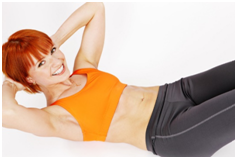 Core conditioning is a multi-faceted jewel that is key to enjoying a healthy life. On so many different levels we need to be more focused on improving core conditioning. I’m going out on a limb here and saying that I believe that at least 95% of “issues” related to poor health are a result of a core challenge.
Core conditioning is a multi-faceted jewel that is key to enjoying a healthy life. On so many different levels we need to be more focused on improving core conditioning. I’m going out on a limb here and saying that I believe that at least 95% of “issues” related to poor health are a result of a core challenge.
For years I dealt with an abdominal muscle tear that made doing sit-up exercises impossible! I felt like a hypocrite, spending all day teaching my Pilates clients how to find and use their mid-sections, and mine was so broken I couldn’t even roll over in bed! But what I learned through the process of recovering from this injury, was how many other muscle groups, besides just the fab 4 abdominal (Transverse, Internal & External Obliques, and Rectus) muscles are necessary for healthy movement. And I was forced to listen to my body and act accordingly. You see I had about 10-12 years where flexing my rectus, or doing 1-sided exercises caused me immediate abdominal pain, and prohibited my injury from fully healing. I had to get creative in finding other muscles to help support movement so I could continue to be active. I had to make smart exercise choices that allowed me to enjoy full body workouts without causing strain and pain on my abdominal tear. I had to let go of my ego and be happy that I was able to do something, and not whine about what I wasn’t able to do. Then I had to do what I could do regularly, listen to my body, and just work at my own pace. And patience…. lots of patience.
Now I can pretty much do what I want with my abs without fear, pain, or negative repercussions. But it was a looong time getting back to this point. Even when I work with clients who have never had an abdominal injury – it can be quite the journey trying to find, feel, and activate the right muscles to maximize healthy movement.
I suppose this is why I so strongly promote improving posture, pelvic floor support, and gaining a better understanding of the fundamentals of functional movement. Clients regularly comment, “Why didn’t anybody teach this to me sooner…?” Body mechanics matter to keep your body injury free. If anything hurts to move, chances are there’s a kink in your functional movement pattern. Understanding what you’re doing is super-important. Being able to send the right message to the muscles and feeling the right muscles doing the work will get you the results you want from your efforts. Not fixing the “kinks,” or ignoring them, only leads to chronic pain and a less active lifestyle.
One of my first Pilates clients 20+ years ago had an impossible time finding, and feeling her abdominal muscles engage. We worked diligently together, me with my hand on her belly while she worked on core-focused exercises, saying, “Can you feel it? That’s great! Yes, that was a good rep.” And over and over she’d reply, “Can’t feel a thing.” I could physically see that her body was in good positioning for each exercise, and I could also see and feel the right muscles working. But she had no self-awareness.
Then one day as she was lying on the Cadillac, she looked up at me and said, “If it seems like I’m not quite all here with you and focused on what we’re doing, it’s because I’m still trying to integrate my multiple personalities!” And then she shared a little bit more about her personal story. This was something she’d neglected to share on her health history forms and it completely explained the disconnect with feeling what her body was doing during exercise.
Healing trauma can be from a physical injury, an emotional one, or both. I was so proud of the fact that she came to Pilates and stuck with it – as uncomfortable as it must have been with someone constantly asking her to pay attention to her center! She was ready to begin her healing process, and one of the best ways to get in better touch with your body is thru movement.
Another client I had, refused to try any exercise I asked her to do at our very first session. Because she was unwilling to try, I offered to refund her money and send her on her way, explaining that I couldn’t help her if she didn’t trust me (at least a little bit…). She was so afraid from getting hurt working with other trainers and therapist. Some had given her exercises, but didn’t help show her how to do them correctly. Others didn’t help her break things down, and build them up to get to the exercise they wanted her to do, when she was unable to do what they were asking safely.
After our little chat, she decided to participate in our “team effort” of helping her get out of her neck for sit-ups, strengthen her low center to reduce back pain, improve balance, and get stronger to climb stairs without fear of falling. Everything we did during our training sessions was goal-oriented to her personal health goals. Once she understood that almost every exercise we did was a stepping-stone to her goal of safely climbing stairs, and that core support was critical for improving this, she was on board, and enthusiastic to try anything I asked her to do. She gained confidence each time we did an exercise and she did it right, because it didn’t hurt her body. Any little aches or pains she felt, we were able to quickly fine-tune before they became a problem. Her confidence grew with each exercise we did, and before long she was gleefully running up and down the stairs.
Not every exercise is for everyone! Knowing what you can do safely and what you should avoid is an important part of self-care. Knowing why you’re doing exercises, and how to scale them easier, or more challenging can help you work at your own pace. Paying attention to how your body feels and being able to make adjustments “on-the-fly” will ensure that you stay safe and injury-free.
I was reading an exercise forum recently and an instructor was ranting about how she had someone in her class that wasn’t listening or doing any of the exercises the way she wanted them done. And I thought to myself – Bravo class participant! You just might be listening to your body and doing what you know it needs. I always encourage my group training folks to stop when they need to, adjust springs to their ability level, and there are quite a few days when we have moments that everybody in class is doing a slightly different exercise – because it’s the most appropriate exercise for them.
In my opinion, I’d rather have people doing what they know is a better choice for their body – than keeping up with the crowd and getting hurt!
What do you do when you’re in a situation to have to make a choice that might not be the best one for you? Succumb to peer pressure? Frightened to be the odd man out? Feel a-OK asking for an alternate choice? Or move ahead with confidence brilliantly blazing your own trail to make smart choices that you know will benefit your good health? I hope you’re a trailblazer! Or at least not too shy to ask for help when you know you need assistance.
My motto is, “When in doubt, leave it out.”
This may not mean leave it out forever… I’ve learned over the years, with my own body, and working with clients, that what you can’t do safely today, you might be able to do eventually, once you’re brain and body has gone thru the process it needs to better understand what needs to happen, how to get support in the right places, and retrain the dominant/weaker parts of the body to participate appropriately. Sometimes it’s easy to just forge ahead and take on a new challenge. And sometimes it’s best to go back to basics, fine-tune things first; then take the next leap forward.
Injuries tend to give us the opportunity to get back to basics. Do you ever wonder what it would be like if you had enough basics under your belt, (and continually refreshed them) to never end up with an injury? (This is a dream, and goal I have for my body, and I’d love to help others achieve it too.) Because I believe it’s possible if we’re in-tune and paying attention to what our bodies tell us, we can act on this information, and be completely in charge of maintaining optimal health. Every day is an opportunity to pay better attention, and make better choices that enhance wellness, of mind, body, and spirit.
Improve core conditioning by listening to your body to improve core strength and whole-body health? Exercise choices matter. The physical connection to your core supports posture and healthy movement. The emotional connection to your core keeps you grounded and “centered.” Listening to your gut intuition will keep you safe, boost confidence, and empower you to make smart decisions that affect your good health.
******
One of my favorite, “get-to-the-deep-layers-of-support, stability, and better movement activation is by doing the Pulse Power Daily Dozen 10 Minute Workout. These exercises can really help you zero in on finding and feeling what you need to use to improve core conditioning, and activate better core support for upper and lower body exercises too! Snag a copy of the Pulse Power ebook at Centerworks.com Or get the Kindle version in the Amazon store.


0 Comments